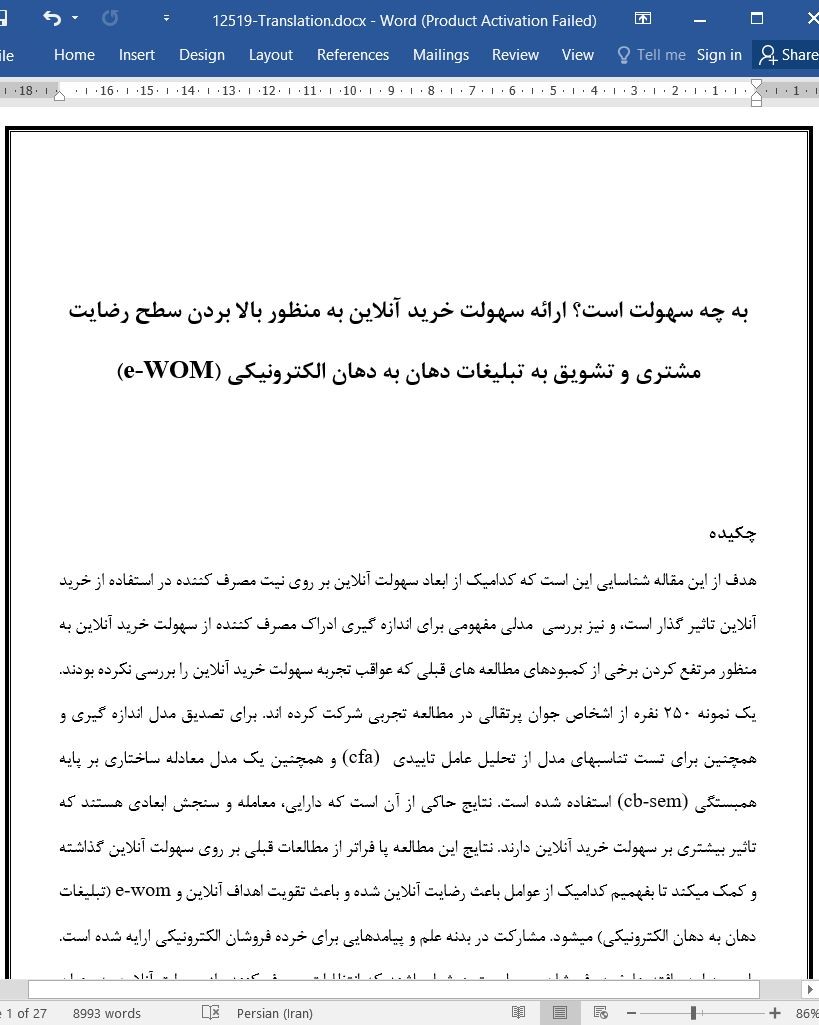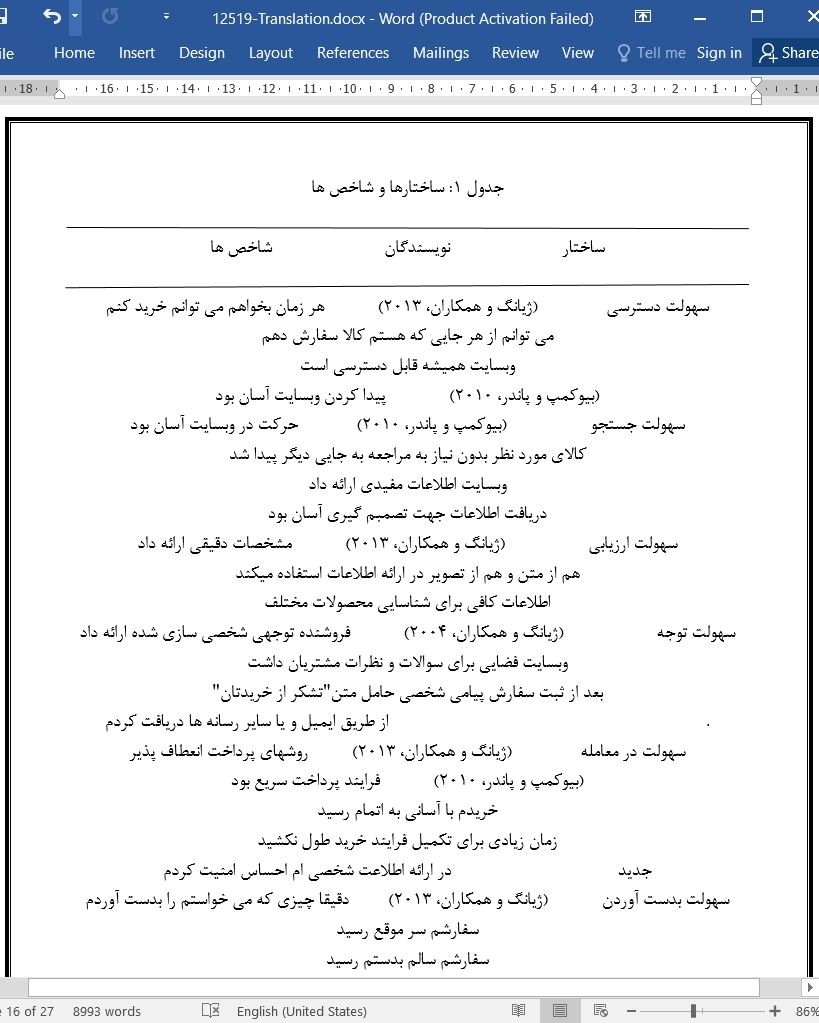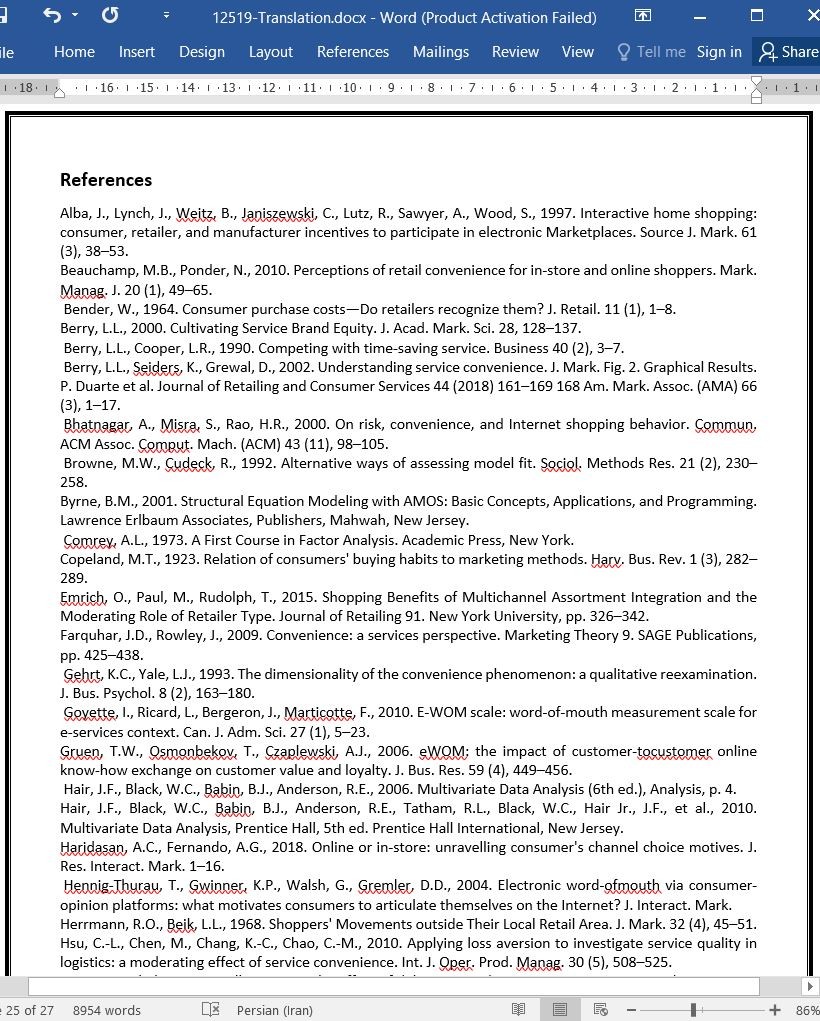
دانلود مقاله ارائه سهولت خرید آنلاین به منظور بالا بردن سطح رضایت مشتری و تشویق به تبلیغات دهان به دهان الکترونیکی
چکیده
هدف از این مقاله شناسایی این است که کدامیک از ابعاد سهولت آنلاین بر روی نیت مصرف کننده در استفاده از خرید آنلاین تاثیر گذار است، و نیز بررسی مدلی مفهومی برای اندازه گیری ادراک مصرف کننده از سهولت خرید آنلاین به منظور مرتفع کردن برخی از کمبودهای مطالعه های قبلی که عواقب تجربه سهولت خرید آنلاین را بررسی نکرده بودند. یک نمونه 250 نفره از اشخاص جوان پرتقالی در مطالعه تجربی شرکت کرده اند. برای تصدیق مدل اندازه گیری و همچنین برای تست تناسبهای مدل از تحلیل عامل تاییدی (cfa) و همچنین یک مدل معادله ساختاری بر پایه همبستگی (cb-sem) استفاده شده است. نتایج حاکی از آن است که دارایی، معامله و سنجش ابعادی هستند که تاثیر بیشتری بر سهولت خرید آنلاین دارند. نتایج این مطالعه پا فراتر از مطالعات قبلی بر روی سهولت آنلاین گذاشته و کمک میکند تا بفهمیم کدامیک از عوامل باعث رضایت آنلاین شده و باعث تقویت اهداف آنلاین و e-wom (تبلیغات دهان به دهان الکترونیکی) میشود. مشارکت در بدنه علم و پیامدهایی برای خرده فروشان الکترونیکی ارایه شده است. با وجود این یافته ها خرده فروشان می بایست هوشیار باشند که انتظارات مصرف کننده از سهولت آنلاین به عنوان واکنشی طبیعی به نوآوری های بوجود آمده توسط مدیران وبسایت ها و بازاریابان، افزایش یافته است. بنابراین نظارت متعدد بر ادراک و انتظارات مصرف کننده از سهولت آنلاین پیش نیازیست برای بدست آوردن بهبود مستمر در ارایه خدمات آنلاین مناسب.
1.مقدمه
تصمیم گیری مشتری به طور قابل ملاحظه ای تحت تاثیر سرعت و سهولتی است که مشتری می تواند با بازار فروش خرده فروش ارتباط برقرار کند. بسیاری از مصرف کننده ها روی به اینترنت می آورند تا زحمت تصمیم گیری را کاهش دهند (بیوکمپ و پاندر، 2010). هنگام خرید مصرف کننده ها زمان صرف کرده و تلاش میکنند تا چندین کار را انجام دهند و از آنجایی که مصرف کننده امروزی بیش از قبل زمان کمی در اختیار دارد، بهتر است مزایای ارائه سهولت خرید آنلاین را در نظر بگیریم. سهولت آنلاین یکی از ترویج کنندگان اصلی میل مشتریان به اتخاذ کردن خرید آنلاین بوده است (ژیانگ و همکاران، 2013). (سیدرز و همکاران، 2000) می گویند اهمیتی که مشتریان به سهولت می دهند خرده فروشان را وادار میکند که سیستم عامل های فروشگاه را از نو طراحی کرده و روی بهره وری سرویس ارائه شده تاکید کنند. در سطحی دیگر خرده فروشان می بایست بر روی افزایش نرم افزارهای تلفن همراه و اینکه چگونه آنها نشانگر ارزش دادن مشتریان به وقت و انرژیشان است تمرکز کنند. این مطالعه مطرح کننده این است که مصرف کننده ها خرده فروشانی را ترجیح می دهند که در وقت و انرژیشان صرفه جویی می کنند. خرده فروشان آنلاین قطعا سهولت بیشتری ارائه می دهند زیرا مکان فروشگاه غیر ضروری شده است و مصرف کنندگان امروزه می توانند از هرمکانی در هر ساعتی و هر روزی خرید کنند (بیوکمپ و پاندر، 2010).
7. محدودیت ها و تحقیقات آتی
یکی از محدودیت های بزرگ این تحقیق عدم وجود تحقیقات پیشین در رابطه با سهولت خرید آنلاین و ابعاد آن در کل و در بازار پرتقال است. در درجه دوم، بر خلاف تلاشهای مولفان برای بدست آوردن نمونه ای بزرگ، تعداد پاسخگویان بصورت نا امید کننده و نا مطلوبی متنوع نبود، زیرا بخش بزرگی از آن دانشجویان بودند، که می تواند بر روی یافته ها تاثیر گذاشته باشد. بدین ترتیب، نمونه ای بزرگتر و متنوع تر می توانست نتایج متفاوتی داشته باشد. یافته ها همچنین نشانگر این بود که نتایج می توانست از چندین معیار بهبود یافته برای چندین ساختار از جمله: سهولت در انجام معامله و سهولت بدست آوردن کالا بهره بگیرد. در تحقیقات آتی تشویق به تمایز بهتر میان سهولت بدست آوردن کالا و سهولت در انجام معامله می شود.
همچنین پیشنهاد می شود تحقیقات آتی چگونگی تغییر ادراک مشتری از سهولت خرید آنلاین را با استفاده از روش تحقیق طولی و اضافه کردن چند بعد به منظور تصحیح کردن مفهوم سهولت خرید آنلاین را مورد بررسی قرار دهند.
Abstract
The purpose of this article is to identify which dimensions of online convenience affect consumers’ intention of using online shopping and explore a conceptual model to measuring consumer perceptions of online shopping convenience in order to surpass the shortcomings of previous studies that did not examine the consequences of convenience shopping experience. A sample of 250 Portuguese young individuals participate in the empirical study. Confirmatory Factor Analysis (CFA) and a covariance-based Structural Equation Model (CB-SEM) were used to validate the measurement model and to test the relationships in the model. The results reveal that Possession, Transaction, and Evaluation are the dimensions with more influence in online shopping convenience. The outcomes of this study extend previous works on online convenience and help to understand which factors drive online satisfaction and enhance behavioral intentions and e-WOM. Contributions to the body of knowledge and the implications for e-commerce retailers are presented. In face of the findings, retailers should be conscious that customer expectations of online convenience have increased as a natural response to the service innovations introduced by website managers and marketers. Therefore, frequent monitoring of consumers’ perceptions and expectations about online convenience is a prerequisite for achieving continuous improvement in rendering highly convenient online service.
1. Introduction
Consumer decision making is significantly influenced by both the speed and ease with which consumers can contact retail outlets. Many consumers turn to the Internet to reduce the effort associated with making a decision (Beauchamp and Ponder, 2010). While shopping consumers spend time and effort to complete multiple tasks and since today's customer is more time-starved than ever, it is appropriate to consider the benefits of providing online shopping convenience. Online convenience has been one of the principal promoters of customer's predisposition to adopt online purchasing (Jiang et al., 2013). Seiders et al. (2000) argue that the importance that customers put on convenience prompts retailers to redesign store operating systems and emphasize the efficiency of the service provided. At another level, retailers should focus on the increase of mobile apps and how they helped fuel and define how consumers value time and energy. The present study argues that consumers favor retailers that save them time and energy. Online retailers are certainly able to supply more convenience as store location becomes irrelevant and consumers may now shop from any location, 24 h a day, seven days a week (Beauchamp and Ponder, 2010).
7. Limitations and future research
One of the major limitations of this study is that there is a significant lack of prior research concerning online shopping convenience and its dimensions, in general, and in the Portuguese market. Second, despite the efforts of the authors to attain a large sample, the number of respondents was disappointing and unsatisfactorily diversified since a significant part are students, which may have influenced the findings. Thus, a more large and diversified sample could produce different conclusions. The findings also indicate that the results would benefit from improved measures for several constructs, namely: search, possession and transaction convenience. In future studies, a better discrimination between possession and transaction convenience is also encouraged.
It is also recommended that future research investigate the how the customer perception of online shopping convenience change over time by employing a longitudinal research method and maybe add additional dimensions to refine online convenience conceptualization.
H1:. The greater the perceived access convenience, the greater the perceived online convenience.
H2:. The greater the perceived search convenience, the greater the perceived online convenience.
H3:. The greater the perceived evaluation convenience, the greater the perceived online convenience.
H4:. The greater the perceived attentiveness convenience, the greater the perceived online convenience.
H5:. The greater the perceived transaction convenience, the greater the perceived online convenience.
H6:. The greater the perceived possession convenience, the greater the perceived online convenience.
H7:. The greater the perceived post-possession convenience, the greater be perceived online convenience.
H8:. The perceived of online convenience has a positive impact on online customer satisfaction.
H9:. Online customer satisfaction has a positive impact on behavioral intentions.
H10:. Online customer satisfaction has a positive impact on e-WOM.
H1:. هر چقدر سهولت دسترسی ادراکی بیشتر باشد، سهولت آنلاین ادراکی نیز بیشتر است.
H2: هرچقدر سهولت جستجوی ادراکی بیشتر باشد، سهولت آنلاین ادراکی نیز بیشتر خواهد بود.
H3:. هرچقدر سهولت ادراکی ارزیابی بیشتر باشد، سهولت ادراکی آنلاین نیز بیشتر خواهد بود.
H4:. هرچقدر سهولت ادراکی توجه بیشتر باشد، سهولت ادراکی آنلاین نیز بیشتر خواهد بود.
H5:. هچقدر سهولت ادراکی معامله بیشتر باشد، سهولت ادراکی آنلاین نیز بیشتر خواهد بود.
H6:. هرچقدر سهولت ادراکی بدست آوردن بالاتر باشد، سهولت ادراکی آنلاین نیز بیشتر خواهد بود.
H7:. هرچقدر سهولت ادراکی پس از بدست آوردن بیشتر باشد، سهولت ادراکی آنلاین نیز بیشتر خواهد بود.
H8:. سهولت ادراکی آنلاین تاثر مثبتی بر روی رضایت آنلاین مشتری می گذارد.
H9:. رضایت مندی مشتری آنلاین تاثیر مثبتی بر روی نیت های رفتاری دارد.
H10:. رضایت خریداران آنلاین تاثیر مثبتی بر E-wom می گذارد
چکیده
1.مقدمه
2. سهولت آنلاین
3.ابعاد سهولت آنلاین و تحلیل و بررسی رابطه ها
3.1 سهولت دسترسی
3.2 سهولت جستجو
3.3 سهولت ارزیابی
3.4 سهولت توجه
3.5 سهولت در انجام معامله
3.6 سهولت بدست آوردن کالا
3.7 سهولت پس از بدست آوردن
3.8 رضایت آنلاین
3.9 نیت های رفتاری
3.10 تبلیغات دهان به دهان الکترونیکی (E-wom)
4.روش
4.1 ابزار جمع آوری اطلاعات و مقیاس ها
4.2 نمونه
4.3 روش تجزیه و تحلیل اطلاعات
5. نتایج
5.1 تجزیه و تحلیل توصیفی
5.2 تحلیل عامل تاییدی
5.3 تجزیه و تحلیل مدل ساختاری
6. نتیجه گیری و پیامدها
7. محدودیت ها و تحقیقات آتی
منابع
ABSTRACT
1. Introduction
2. Online convenience
3. Online convenience dimensions and relationships analysis
3.1. Access convenience
3.2. Search convenience
3.3. Evaluation convenience
3.4. Attentiveness convenience
3.5. Transaction convenience
3.6. Possession convenience
3.7. Post-possession convenience
3.8. Online satisfaction
3.9. Behavioral intentions
3.10. Electronic Word-of-mouth (e-WOM)
4. Method
4.1. Data collection instrument and scales
4.2. Sample
4.3. Data analysis procedures
5. Results
5.1. Descriptive analysis
5.2. Confirmatory factor analysis
5.3. Structural model analysis
6. Conclusions and implications
7. Limitations and future research
References
- ترجمه فارسی مقاله با فرمت ورد (word) با قابلیت ویرایش، بدون آرم سایت ای ترجمه
- ترجمه فارسی مقاله با فرمت pdf، بدون آرم سایت ای ترجمه



